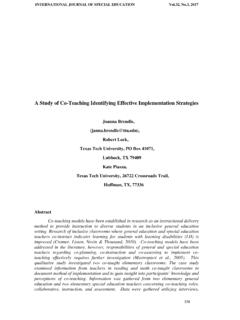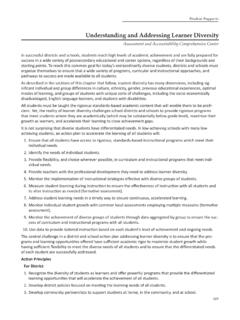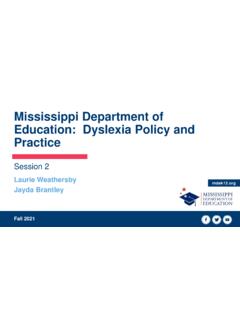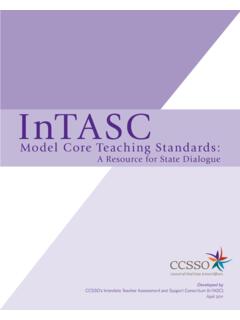Transcription of Including pupils with SEN and/or disabilities in primary PE
1 Special educational needs and/or disabilitiesTraining toolkitFor primary PGCE tutors and trainees Including pupils with SEN and/or disabilities in primary physical educationIncluding pupils with SEN and/or disabilities in primary physical education2 Contents1 Including pupils with SEN and/or disabilities in primary physical education (PE) lessons 32 Removing barriers to the primary physical education curriculum for pupils with SEN and/or disabilities 63 Self-audit for inclusive physical education lessons: planning teaching, learning and support 74 Physical education and Every Child Matters 245 Early development in the National Curriculum: the P scales for physical education 266 Bilingual learners 277 Sources of information and advice 28 Appendix A: Including all pupils in the physical education curriculum 293 Including pupils with SEN and/or disabilities in primary physical educationIncluding pupils with SEN and/or disabilities in primary physical education (PE) lessons1 IntroductionThis booklet gives tutors and trainees information about subject-specific issues in the physical education curriculum for pupils with SEN and/or disabilities .
2 It offers a straightforward introduction to planning inclusive physical education lessons. There are also suggestions for further reading and support in section booklet in this series contains a self-audit table (section 3). This offers a range of ideas that you can use to check against your practice and the practice you observe. The organisation of information in this table is based on the most recent research evidence and the views of expert evidence (eg Davis and Florian, 2004) suggests that much of what has traditionally been seen as pedagogy for pupils with SEN and/or disabilities consists of the approaches used in ordinary teaching, extended or emphasised for particular individuals or groups of pupils .
3 This applies even when teaching approaches may look very different, eg when teachers are working with pupils with complex needs. Trials of these materials in 2007/08 suggested that grouping teaching approaches into themes helps new teachers and those who work with them to consider and discuss their practice. Therefore each self-audit table is grouped under eight themes:maintaining an inclusive learning environment "multi-sensory approaches, Including information and communication technology (ICT) "working with additional adults "managing peer relationships "adult-pupil communication " formative assessment / assessment for learning "motivation, and "memory/consolidation.
4 "There are many overlaps between these themes, but the model offers a useful starting point to help you develop teaching approaches that include pupils with SEN and/or disabilities . 4 Including pupils with SEN and/or disabilities in primary physical educationPhysical education A high-quality PE curriculum enables all pupils to enjoy and succeed in many kinds of physical activity. They develop a wide range of skills and the ability to use tactics, strategies and compositional ideas to perform successfully. When they are performing, they think about what they are doing, analyse the situation and make decisions. They also reflect on their own and others performances and find ways to improve them.
5 As a result, they develop the confidence to take part in different physical activities and learn about the value of healthy, active lifestyles. Discovering what they like to do, what their aptitudes are at school, and how and where to get involved in physical activity helps them make informed choices about lifelong physical activity. PE helps pupils develop personally and socially. They work as individuals, in groups and in teams, developing concepts of fairness and of personal and social responsibility. They take on different roles and responsibilities, Including leadership, coaching and officiating. Through the range of experiences that PE offers, they learn how to be effective in competitive, creative and challenging situations.
6 National Curriculum, QCA, 2009 Roles and responsibilitiesRecent legislation and guidance make clear that all the teaching staff in a school are responsible for the provision for pupils with SEN and/or disabilities . All staff should be involved in developing school policies and fully aware of the school s procedures for identifying, assessing and making provision for pupils with SEN and/or disabilities . Staff should help pupils with SEN to overcome any barriers to participating and learning, and make any reasonable adjustments needed to include disabled pupils in all aspects of school Disability Discrimination Act (DDA) has substantial implications for everyone involved in planning and teaching the curriculum.
7 Schools have specific duties under the DDA to:make reasonable adjustments to their policies and practice to prevent discrimination against "disabled pupilsincrease access for disabled pupils , Including access to the curriculum, through accessibility "planning, and promote disability equality and have a disability equality scheme showing how they will do so. "These duties are important and significant. They require schools to: take a proactive, systematic and comprehensive approach to promoting disability equality and "eliminating discrimination, and build disability equality considerations in from the start at every level of activity, Including "developing and delivering the curriculum and classroom practice.
8 Schools must address their various DDA duties together in a way that brings greater benefits to disabled pupils , staff, parents and other users of the school. Using the self-audit table in this booklet to develop an inclusive approach to your teaching will help you carry out these duties in your pupils with SEN and/or disabilities in primary physical educationModifying the curriculum and the National Strategies to match pupils needs Teachers have a statutory duty to modify the programmes of study (or National Strategy materials). Schools have a responsibility to provide a broad and balanced curriculum for all pupils . National Curriculum, QCA, 2008 This is more than just giving pupils access to the curriculum.
9 The curriculum is not immovable, like some building, to which pupils with SEN and/or disabilities have to gain access. It is there to be changed, where necessary, to include all pupils . The statutory inclusion statement in the National Curriculum sets out a framework for modifying the curriculum to include all pupils . Teachers have to:set suitable learning challenges "respond to pupils diverse learning needs, and "overcome potential barriers to learning and assessment for particular individuals and "groups of principles allow you to:choose objectives for pupils with SEN and/or disabilities that are different from those of the rest "of the group, or modify the curriculum to remove barriers so all pupils meet the same objectives.
10 "Planning for pupils with SEN and/or disabilities should be part of the planning that you do for all pupils , rather than a separate activity. It doesn t need to be complicated or time-consuming. You can simply jot down brief notes in your lesson plans on the learning objectives and approaches you will use to remove barriers for pupils with SEN and/or disabilities . Any personal targets the pupil has can inform this planning. At times it may be appropriate to plan smaller steps to achieve the learning goal or provide additional resources. It is often possible to use the support available to do this, either from the SENCO or teaching assistant/mentor. You should also think about the questions you will ask different groups and individuals and the ways you will check that pupils understand.

















